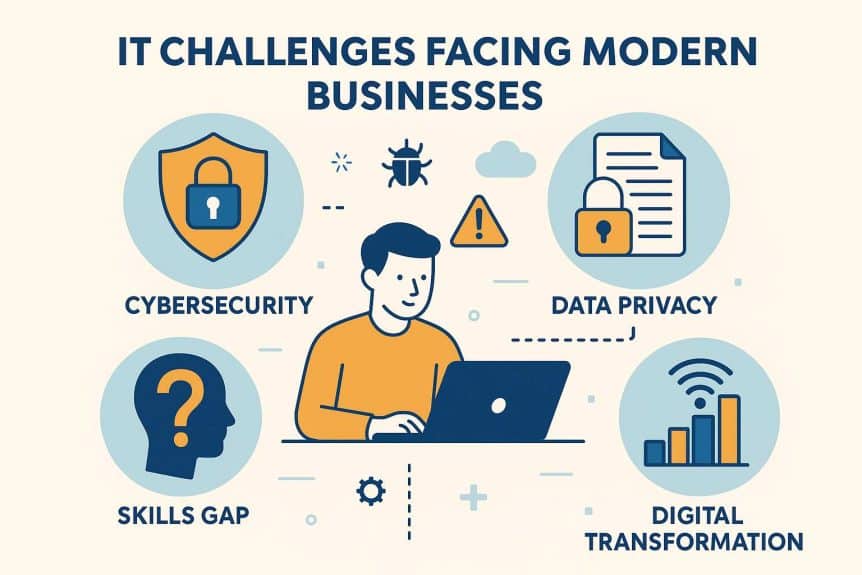Running a business nowadays means playing with technology at every turn. IT has become the lifeline of everyday activities, whether handling customer data or maintaining the smooth running of systems. Yet many companies find it challenging to meet the technology’s requirements, which can create barriers that can slow growth and drain resources. All organisations face these obstacles and create roadblocks that require immediate attention. The IT challenges facing businesses continue to multiply as digital transformation and cyber threats increase.
Let’s discuss the most common IT problems in business today and find effective solutions to address them.
Cybersecurity threats are creating the biggest IT challenges
Security is one of the biggest IT challenges that keeps expanding. Hackers attack businesses with ransomware, phishing attacks, and data breaches that may shut down businesses overnight. Small businesses often believe they are too insignificant to attract attention, yet statistics show that 60% of small businesses fail within six months of a significant cyber attack.
Important security solutions are:
- Install firewalls and anti-virus software that are updated regularly
- Train employees about phishing and email scams
- Enable multi-factor authentication within all business systems
- Maintain regular off-site backup to protect against ransomware
- Outsource managed cybersecurity services for expert monitoring
Outdated technology slowing down your operations creates IT problems in business
Outdated technology creates bottlenecks throughout organisations. Many businesses run on systems installed years ago, patched together with temporary fixes that have become permanent. These old systems are incompatible with newer programmes, and the employees waste time on manual workarounds and duplicate data entry.
Adopt small business IT solutions for this issue
Small businesses require strategic planning. Conduct an audit on existing systems to see which applications require urgent replacement. Secondly, cloud migration removes several hardware headaches and improves accessibility for remote teams. Phased implementation eliminates disruption, so replace one system at a time instead of trying to do a total upgrade. Then keep a record of all the procedures during the change of locations to ensure continuity and train employees correctly on the new tools.
You can also safeguard essential data with a business and charity backup disaster recovery service to ensure business continuity even after unexpected failures.
Drowning in data with no clear organisation increases IT problems in business
One cause of IT problems in businesses is poor data handling. Every day, information continues to multiply in email attachments, cloud drives, local servers, and devices. Finding a particular file becomes a treasure hunt, and copying files uses storage space and creates version control nightmares.
Every problem has a solution, and so does solving data management problems. Effective data strategies are:
- Create standardised naming systems and folder structures that everyone follows
- Implement centralised storage systems in which the team can work collaboratively without generating duplicate copies
- Create automated backup systems to prevent data loss
- Regular cleanup schedules help maintain organisation
- Strengthen devices and networks using a business charity endpoint protection service to safeguard against unauthorised access and malware
The struggle to find qualified IT professionals is one of the IT challenges facing businesses
The technical skills gap affects every industry. One of the IT issues SMEs face against larger corporations is the qualified professionals. Although firms may hire talented employees, retention is another fight as competitors steal talent with higher packages. And the small internal teams are overwhelmed with the responsibility of handling help desk tickets and strategic planning.
Practical staffing solutions:
- Hand over normal maintenance to managed service providers
- Train new staff to create redundancy
- Provide flexible working conditions and growth
- Establish connections with the local technical schools for recruitment
Stretching limited IT budgets across growing needs
IT pitfalls in business are often related to funding. Technology has to be continuously invested in, hardware needs replacement, software needs upgrades, and security systems need tightening. Meanwhile, management questions IT spending because returns aren’t immediately visible like sales or marketing results.
This IT budget issue can be handled with innovative solutions.
Maximising IT budgets
Demonstrate value by tracking metrics connecting IT performance to business outcomes; prioritise investments based on risk assessment and impact analysis. Look for grants and tax incentives supporting IT adoption. IT support challenges decrease when management understands technology as an investment rather than an expense, driving competitive advantage.
Moving forward with confidence
IT issues will never disappear, but the proactive measures considerably lessen their effects. Address security initially since breaches cause catastrophic damage. Adapt the newer systems rather than delaying until the systems fail altogether. Those businesses that thrive treat IT as a strategic key area, allocate resources appropriately, and seek professional advice when internal resources are insufficient.
Cygnet IT Services, the trusted company, helps businesses handle these complex challenges with bespoke solutions that match their specific needs and budgets. With professional help, these IT problems and solutions in a business form the basis of sustainable growth.




